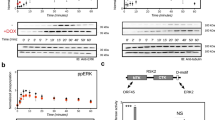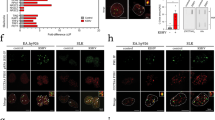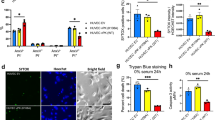Abstract
Kaposi's sarcoma-associated herpesvirus (KSHV) is a newly discovered herpesvirus etiologically associated with Kaposi's sarcoma (KS) and two lymphoproliferative disorders. We describe a KSHV vbcl-2 gene with homology to the proto-oncogene bcl-2. It is expressed in KS lesions and in cell lines derived from primary effusion lymphomas. Using yeast and human cells we demonstrate the ability of KSHV vBcl-2 protein to suppress Bax toxicity. We show that KSHV vBcl-2 heterodimerizes with human Bcl-2 in a yeast two-hybrid system. These results suggest that KSHV vBcl-2 plays an anti-apoptotic role in virus infected cells.
This is a preview of subscription content, access via your institution
Access options
Subscribe to this journal
Receive 12 print issues and online access
$209.00 per year
only $17.42 per issue
Buy this article
- Purchase on Springer Link
- Instant access to full article PDF
Prices may be subject to local taxes which are calculated during checkout
Similar content being viewed by others
References
Moore, P.S. et al. Primary characterization of a herpesvirus-like agent associated with Kaposi's sarcoma. J.Virol. 70, 549–558 (1996).
Chang, Y. et al. Identification of herpesvirus-like DNA sequences in AIDS-associated Kaposi's sarcoma. Science 265, 1865–1869 (1994).
Moore, P.S. & Chang, Y. Detection of herpesvirus-like DNA sequences in Kaposi's sarcoma lesions from persons with and without HIV infection. N. Eng. J. Med. 332, 1181–1185 (1995).
Boshoff, C. et al. Kaposi's sarcoma-associated herpesvirus in HIV-negative Kaposi's sarcoma. Lancet 345, 1043–1044 (1995).
de tellis, L. et al. Herpesvirus-like DNA sequences in non-AIDS Kaposi's sarcoma. J. Inf. Dis. 172, 1605–1607 (1995).
Schalling, M., Ekman, M., Kaaya, E.E., Linde, A. & Biberfeld, P. A role for a new herpesvirus (KSHV) in different forms of Kaposi's sarcoma. Nature Med. 1, 707–708 (1995).
Chang, Y. et al. Kaposi's sarcoma-associated herpesvirus DNA sequences are present in African endemic and AIDS-associated Kaposi's sarcoma. Arch. Int. Med. 156, 202–204 (1996).
Whitby, D. et al. Detection of Kaposi's sarcoma-associated herpesvirus (KSHV) in peripheral blood of HIV-infected individuals predicts progression to Kaposi's sarcoma. Lancet 364, 799–802 (1995).
Moore, P.S. et al. KSHV infection prior to onset of Kaposi's sarcoma. AIDS 10, 175–180 (1996).
Miller, G. et al. Antibodies to butyrate inducible antigens of Kaposi's sarcoma-associated herpesvirus in HIV-1 infected patients. N. Eng. J. Med. 334, 1292–1297 (1996).
Gao, S.-J. et al. KSHV antibodies among Americans, Italians and Ugandans with and without Kaposi's sarcoma. Nature Med. 2, 925–928 (1996).
Kedes, D.H. et al. The seroepidemiology of human herpesvirus 8 (Kaposi's sarcoma-associated herpesvirus): distribution of infection in KS risk groups for sexual transmission. Nature Med. 2, 918–924 (1996).
Gao, S.-J. et al. Seroconversion of antibodies to Kaposi's sarcoma-associated herpesvirus-related latent nuclear antigens prior to onset of Kaposi's sarcoma. N. Eng. J. Med. 335, 233–241 (1996).
Cesarman, E., Chang, Y., Moore, P.S., Said, J.W. & Knowles, D.M. Kaposi's sarcoma-associated herpesvirus-like DNA sequences are present in AIDS-related body cavity based lymphomas. N. Eng. J. Med. 332, 1186–1191 (1995).
Soulier, J. et al. Kaposi's sarcoma-associated herpesvirus-like DNA sequences in multicentric Castleman's disease. Blood 86, 1276–1280 (1995).
Frizzera, G., Peterson, B.A., Bayrd, E.D. & Goldman, A. A systemic lymphopro-liferative disorder with morphologic features of Castleman's disease: clinical findings and clinicopathologic correlations in 15 patients. J. Clin. Oncol. 3, 1202–1216 (1985).
Strauchen, J.A. et al. Kaposi's sarcoma, Kaposi's sarcoma-associated herpesvirus, and body cavity-based malignant lymphoma in an HIV-negative man. Ann. Intern. Med. 125, 822–825 (1996).
White, E. Regulation of apoptosis by the transforming genes of the DNA tumor virus adenovirus. [Review]. Proc. Soc. Exper. Biol. & Med. 204, 30–39 (1993).
Gregory, C.D. et al. Activation of Epstein-Barr virus latent genes protects human B cells from death by apoptosis. Nature 349, 612–614 (1991).
Henderson, S. et al. Epstein-Barr virus-coded BHRF1 protein, a viral homologue of Bcl-2, protects human B cells from programmed cell death:. Proc. Natl. Acad. Sci. U.S.A. 90, 8479–8483 (1993).
Vaux, D.L., Haecker, G. & Strasser, A. An evolutionary perspective on apoptosis. Cell 76, 777–779 (1994).
Vaux, D.L., Cory, S. & Adams, J.M. Bcl-2 gene promotes haemopoietic cell survival and cooperates with c-myc to immortalize pre-B cells. Nature 335, 440–442 (1988).
Garcia, I., Martinou, I., Tsujimoto, Y. & Martinou, J.C. Prevention of programmed cell death of sympathetic neurons by the bcl-2 proto-oncogene. Science 258, 302–304 (1992).
Tsujimoto, Y. & Croce, C.M. Analysis of the structure, transcripts, and protein products of bcl-2, the gene involved in human follicular lymphoma. Proc. Natl. Acad. Sci. U.S.A. 83, 5214–5218 (1986).
Geary, M.L., Smith, S.D. & Sklar, J. Cloning and structural analysis of cDNAs for bcl-2 and a hybrid bcl-2/immunoglobulin transcript resulting from the t (14;18) translocation. Cell 47, 19–28 (1986).
Oltvai, Z.N., Milliman, C.L. & Korsmeyer, S.J. Bcl-2 heterodimerizes in vivo with a conserved homolog, Bax, that accelerates programmed cell death. Cell 74, 609–619 (1993).
Sato, T. et al. Interactions among members of the Bcl-2 protein family analyzed with a yeast two-hybrid system [published erratum appears in Proc.Natl.Acad. Sci.U.S.A. 92, 2016]. Proc. Natl. Acad. Sci. U.S.A. 91, 9238–9242 (1994).
Boyd, J.M. et al. Bik, a novel death-inducing protein shares a distinct sequence motif with Bcl-2 family proteins and interacts with viral and cellular survival-promoting proteins. Oncogene 11, 1921–1928 (1995).
Yang, E. et al. Bad, a heterodimeric partner for Bel-XL and Bcl-2, displaces Bax and promotes cell death. Cell 80, 285–291 (1995).
Cesarman, E. et al. In vitro establishment and characterization of two AIDS-re-lated lymphoma cell lines containing Kaposi's sarcoma-associated herpesvirus-like (KSHV) DMA sequences. Blood 86, 2708–2714 (1995).
Russo, J.J. et al. Nucleotide sequence of Kaposi's sarcoma-associated her-pesvirus (HHV8). Proc. Natl. Acad. Sci. U.S.A. 93, 14862–14867 (1996).
Bankier, A.T., Weston, K.M. & Barrell, B.G. Random cloning and sequencing by the M13/dideoxynucleotide chain termination method. Methods in Enzymology 155, 51–93 (1987).
Altschul, S.F., Gish, W., Miller, M., Myers, E.W. & Lipman, D.J. Basic local alignment search tool. J. Mol. Biol. 215, 403–410 (1990).
Hanada, M., Aime'-Sempe', C., Sato, T. & Reed, J.C. Structure-function analysis of Bcl-2 protein. T. J. Biol. Chem. 270, 11962–11969 (1995).
Bodrug, S.E. et al. Biochemical and functional comparisons of Mcl-1 and Bcl-2 proteins: evidence for a novel mechanism of regulating Bcl-2 family protein function. Death Differen. 2, 173–182 (1995).
Sato, T., Irie, S., Krajewski, S. & Reed, J.C. Cloning and sequencing of a cDNA encoding the rat Bcl-2 protein. Gene 140, 291–292 (1994).
Hunter, J. & Parslow, T. A peptide sequence from Bax that converts Bcl-2 into an activator of apoptosis. Biol. Chem. 271, 8521–8524 (1996).
Miura, M., Zhu, H., Rotello, R., Hartwieg, E.A. & Yuan, J. Induction of apoptosis in fibroblasts by IL-1β-converting enzyme, a mammalian homolog of the C. elegans cell death gene ced-3. Cell 75, 653–660 (1993).
Hockenbery, D., Nunez, G., Milliman, C., Schreiber, R.D. & Korsmeyer, S.J. Bcl-2 is an inner mitochondrial membrane protein that blocks programmed cell death. Nature 348, 334–336 (1990).
Moore, P.S., Boshoff, C., Weiss, R.A. & Chang, Y. Molecular mimicry of human cytokine and cytokine response pathway genes by KSHV. Science 274, 1739–1744 (1996).
Nunez, G. et al. Growth-and tumor-promoting effects of deregulated BCL2 in human B-lymphoblastoid cells. Proc. Natl. Acad. Sci. U.S.A. 86, 4589–4593 (1989).
Biesinger, B. et al. Stable growth transformation of human T lymphocytes by herpesvirus saimiri. Proc. Natl. Acad. Sci. U.S.A. 89, 3116–3119 (1992).
Szomolanyi, E., Medveczky, P. & Mulder, C. In vitro immortalization ofmarmoset cells with three subgroups of herpesvirus saimiri. J. Virol. 61, 3485–3490 (1987).
Miller, G. Epstein-Barr virus: Biology, pathogenesis and medical aspects, in Virology (eds. Fields, B. N. & Knipe, D. M.) 1921–1957 2nd edn. (Raven Press, New York, 1990).
Cesarman, E. et al. Kaposi's sarcoma-associated herpesvirus contains G protein-coupled receptor and cyclin D homologs which are expressed in Kaposi's sarcoma and malignant lymphoma. J. Virol. 70, 8218–8223 (1996).
Chang, Y. et al. KSHV encodes a functional cyclin. Nature 382, 410 (1996).
Nicholas Cameron, K.R. & Honess, R.W. Herpesvirus saimiri encodes homologues of G protein-coupled receptors and cyclins. Nature 355, 362–365 (1992).
Sinclair, A.J., Palmero, I., Peters, G. & Farrell, P.J. EBNA-2 and EBNA-LP cooperate to cause GO to G1 transition during immortalization of resting human B lymphocytes by Epstein-Barr virus. EMBO Journal 13, 3321–3328 (1994).
Shen, Y. & Shenk, T.E. Viruses and apoptosis. [Review]. Curr. Opin. Gen. & Develop. 5, 105–111 (1995).
Golemis, E.A., & Brent, R. Interaction trap/Two-hybrid system to identify interacting proteins. in Current Protocols in Molecular Biology 13.14.1–13.14.17 (John Wiley and Sons, New York, 1994).
Neilan, J.G. et al. An African swine fever virus gene with similarity to the proto-oncogene bcl-2 and the Epstein-Barr virus gene BHRF1. Journal of Virology 67, 4391–4394 (1993).
Smith, R.F. & Smith, T.F. Pattern-induced multiple sequence alignment (PIMA) algorithm employing secondary structure-dependent gap penalties for use in comparative protein modeling. Protein Eng. 5, 35–41 (1992).
Author information
Authors and Affiliations
Rights and permissions
About this article
Cite this article
Sarid, R., Sato, T., Bohenzky, R. et al. Kaposi's sarcoma-associated herpesvirus encodes a functional Bcl-2 homologue. Nat Med 3, 293–298 (1997). https://doi.org/10.1038/nm0397-293
Received:
Accepted:
Issue Date:
DOI: https://doi.org/10.1038/nm0397-293
This article is cited by
-
Cellular and viral oncogenes: the key to unlocking unknowns of Kaposi’s sarcoma-associated herpesvirus pathogenesis
Archives of Virology (2018)
-
Viral hijacking of host caspases: an emerging category of pathogen–host interactions
Cell Death & Differentiation (2017)
-
Apoptosis-induced activation of HIV-1 in latently infected cell lines
Retrovirology (2015)
-
Regulation of the metastasis suppressor Nm23-H1 by tumor viruses
Naunyn-Schmiedeberg's Archives of Pharmacology (2015)
-
Disruption of Bcl-2 and Bcl-xL by viral proteins as a possible cause of cancer
Infectious Agents and Cancer (2014)



